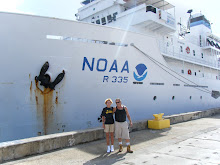
"Wirelessly communicating with Autonomous Underwater Vehicles (AUVs) is very difficult―the type of wireless communications that we rely on in our day-to-day lives does not work underwater. Most wireless systems, like WiFi or mobile phones, rely upon high frequency electromagnetic waves―millions or billions of cycles per second. Underwater, high frequency signals are attenuated, or blocked, over short distances. That is part of why when you are snorkeling or SCUBA diving everything looks blue―the higher frequency red light has been blocked out. To communicate with SeaBED AUVs, we rely upon sound waves, which use only around 12 thousand cycles per second. Echoes, other noise, and a number of other challenges presented by the ocean result in us having a very slow connection to the robot. Also, like using a walkie talkie, only one person can be talking at a time. If we are sending commands to the robot, it can't be sending us information. Finally, sound travels slowly through the water, so it takes time for the message to even get to the boat (this is called latency). That all means we have to heavily compress images so that they are very small on disk before we transmit them, and we don't get all the pieces in the right order. Putting together the image ends up being like putting together a puzzle―you have to make sure you have all the pieces, and then put them together in the right order. The compression means that the images look pretty rough, but they still give us an idea of what the robot is doing, and an early glimpse at the seafloor. For the rest, you have to wait until it comes back up! SeaBED AUVs can take over a thousand images every hour! "
OK, me again. Chris will continue working on this project. He wants to make it easier and faster. With this new trick, the scientists will know, while the AUV is still below, that all systems are working and the AUV is taking quality photos.

 This is day #3 working off-shore of the beautiful island of Rota. While working at Galvez Bank we could see Guam at a distance of about 14 miles, but it was just a big bump on the horizon. While working in this location, we are close to shore and can enjoy the view of tropical vegetation, white sandy beaches and carbonate cliffs. The work in Rota has included BRUVs, multibeam and the AUV.
This is day #3 working off-shore of the beautiful island of Rota. While working at Galvez Bank we could see Guam at a distance of about 14 miles, but it was just a big bump on the horizon. While working in this location, we are close to shore and can enjoy the view of tropical vegetation, white sandy beaches and carbonate cliffs. The work in Rota has included BRUVs, multibeam and the AUV.





 Steve swinging in the long-line pit. This is the area that is used for recovery of the BotCams, BRUVs and the AUV. On other expedtions the area is actually used for long-line fishing as a survey method.
Steve swinging in the long-line pit. This is the area that is used for recovery of the BotCams, BRUVs and the AUV. On other expedtions the area is actually used for long-line fishing as a survey method.












